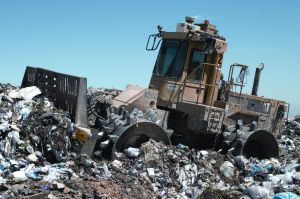Major components of Waste-to-Energy Processes
- Front end MSW pre-processing is used to prepare MSW for treatment and separate any recyclables
- Conversion unit (reactor)
- Gas and residue treatment plant (optional)
- Energy recovery plant (optional): Energy / chemicals production system includes gas turbine, boiler, internal combustion engines for power production. Alternatively, ethanol or other organic chemicals can be produced
- Emissions clean up
Incineration
- Combustion of raw MSW, moisture less than 50%
- Sufficient amount of oxygen is required to fully oxidize the fuel
- Combustion temperatures are in excess of 850oC
- Waste is converted into CO2 and water concern about toxics (dioxin, furans)
- Any non-combustible materials (inorganic such as metals, glass) remain as a solid, known as bottom ash (used as feedstock in cement and brick manufacturing)
- Fly ash APC (air pollution control residue) particulates, etc
- Needs high calorific value waste to keep combustion process going, otherwise requires high energy for maintaining high temperatures
Anaerobic Digestion
- Well-known technology for domestic sewage and organic wastes treatment, but not for unsorted MSW
- Biological conversion of biodegradable organic materials in the absence of oxygen at temperatures 55 to 75oC (thermophilic digestion – most effective temperature range)
- Residue is stabilized organic matter that can be used as soil amendment after proper dewatering
- Digestion is used primarily to reduce quantity of sludge for disposal / reuse
- Methane gas generated used for electricity / energy generation or flared
Gasification
- Can be seen as between pyrolysis and combustion (incineration) as it involves partial oxidation.
- Exothermic process (some heat is required to initialize and sustain the gasification process).
- Oxygen is added but at low amounts not sufficient for full oxidation and full combustion.
- Temperatures are above 650oC
- Main product is syngas, typically has net calorific value of 4 to 10 MJ/Nm3
- Other product is solid residue of non-combustible materials (ash) which contains low level of carbon
Pyrolysis
- Thermal degradation of organic materials through use of indirect, external source of heat
- Temperatures between 300 to 850oC are maintained for several seconds in the absence of oxygen.
- Product is char, oil and syngas composed primarily of O2, CO, CO2, CH4 and complex hydrocarbons.
- Syngas can be utilized for energy production or proportions can be condensed to produce oils and waxes
- Syngas typically has net calorific value (NCV) of 10 to 20 MJ/Nm
Plasma Gasification
- Use of electricity passed through graphite or carbon electrodes, with steam and/or oxygen / air injection to produce electrically conducting gas (plasma)
- Temperatures are above 3000oC
- Organic materials are converted to syngas composed of H2, CO
- Inorganic materials are converted to solid slag
- Syngas can be utilized for energy production or proportions can be condensed to produce oils and waxes
Net Energy Generation Potential Per Ton MSW
|
Waste Management Method |
Energy Potential* (kWh per ton MSW) |
|
Recycling |
2,250 |
|
Landfilling |
105 |
|
WTE Incineration |
585 |
|
Gasification |
660 |
|
Pyrolysis |
660 |
|
Anaerobic Digestion |
250 |
Cost Economics of WTE Processes
|
Technology |
Plant capacity (tons/day) |
Capital cost (M US$) |
O&M cost (US$/ton) |
Planning to commissioning (months) |
|
Pyrolysis |
70-270 |
16 – 90 |
80 – 150 |
12 – 30 |
|
Gasification |
900 |
15 – 170 |
80 – 150 |
12 – 30 |
|
Incineration |
1300 |
30 – 180 |
80 – 120 |
54 – 96 |
|
Plasma gasification |
900 |
50 – 80 |
80 – 150 |
12 – 30 |
|
Anaerobic digestion |
300 |
20 – 80 |
60 – 100 |
12 – 24 |
|
In vessel composting |
500 |
50 – 80 |
30 – 60 |
9 – 15 |
|
Sanitary landfill |
500 |
5 – 10 |
10 – 20 |
9 – 15 |
|
Bioreactor landfill |
500 |
10 – 15 |
15 – 30 |
12 – 18 |




can you including the references to this post? thank you 🙂